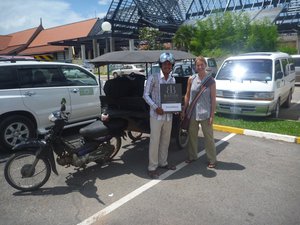Advertisement
Published: October 8th 2014

 Airport Limo!
Airport Limo!
Great fun to be picked up in a TukTuk, much better than "death race 2000", as in Bangkok.Ninety minutes after leaving the hustle and bustle of Bangkok we were in Cambodia. What a contrast. First job was to get a visa. Easy, go to a desk at the airport, hand over completed form, passport and 20$. Immigration officer number one takes that from you, then stuff move down a line of officers, each doing something as part of the process. Officer number ten gets the passport with visa stuck in, looks at the photo, laughs and shows it round, finally announcing the holders name for them to come and collect it. Outside of the airport we were collected by our hotel pickup, in a Tuk Tuk. The drive into Siem Reap was via mostly rural roads with the potential hazards coming not from drivers, at speed, meandering across all three lanes, more from lumbering cattle veering in front of vehicles.
Siem Reap is very much a place on the up. Since 2000 it has been staging a major comeback after the horror of the Khmer Rouge regime. We chatted to one family who had visited three years ago and they commented on a massive increase in tourism, which is the driver for growth in this region. Our

 Angkor Wat
Angkor Wat
Very old (buildings), 12th century.hotel, The Bayon Boutique, is small but very modern, staffed by an excellent team of young Cambodians.
Siem Reap's popularity is based largely on it's proximity to the ancient remains of Angkor Wat, Angkor Thom and other smaller temples. These were at the heart of a highly successful Khmer civilisation that covered most of what is now Cambodia, Vietnam, Laos and Thailand. The remains are spectacular, even now after 600 years of disuse, during which the jungle had regained control and hidden all, until rediscovery at the end of the nineteenth century.
Yesterday we had a full day in and amongst the remains, guided round by Kim, one of the local guides. His knowledge of the history and culture of the region was excellent and his ability to communicate it all to us matched it. We were picked up at 6.30am and dropped back at 4.00pm- exhausted.
Just as interesting, but a bit unsettling was Kim's own story, which must be typical of so many in this country. He cannot remember is parents, he has no photographs either. He was born during the Khmer Rouge times. His father was shot dead, his mother became weak through starvation

 Ta Prohm
Ta Prohm
Literally lost beneath the jungle for 600 years.and died when he was one year old. Not morbid about this, in fact just the opposite, Kim had taken every opportunity that had arisen to progress. Learning English had been a cornerstone, not easy though since poor rural children only have 4 hours a day schooling up until the age of 12. He plans to continue working as a tour guide for the moment, but alongside that take computing courses. Trying to support yourself and pay for education cannot be easy on a monthly income of around 100$.
Today's trip out has been to Tonle Sap, Asia's largest lake. Fishing underpins all of the communities on the lake. For most, life is at its most basic, just subsistence. In fact families are classed as type 1,2 or 3. Type 1 families have little of anything, living in houses made from local natural materials - the basic fishermen, which are the majority. Type 2 families have somehow made a move up, perhaps by being middle men, for example by transporting and selling the fish. They would have better housing with more solid walls and metal or tile roof, plus a few more luxury items. Type 3 had really made

 Tonle Sap Village
Tonle Sap Village
A floating village.it.
Since the lake fills and empties according to the seasons, the houses are either on stilts or are floating on top of oil drums or a boat structure; impressive to see.
Since Siem Reap caters for so many tourists it has many hotels, bars, restaurants and markets. Generally a tourist can walk 3 or 4 metres between being asked if they want a Tuk Tuk, but done very nicely. Many of the bars display signs saying how long they have been in operation; the oldest one we saw was since 1998 - the year Pol Pot died. The place has come a long way since then. We'd love to come back here in a couple of years to see how that journey has continued.
Advertisement
Tot: 0.124s; Tpl: 0.01s; cc: 9; qc: 46; dbt: 0.0886s; 1; m:domysql w:travelblog (10.17.0.13); sld: 1;
; mem: 1.1mb

 Airport Limo!
Airport Limo!
 Angkor Wat
Angkor Wat
 Ta Prohm
Ta Prohm
 Tonle Sap Village
Tonle Sap Village
emma
non-member comment
Sound's fun
I am going to Cambodia in January for about 2 weeks for a mission trip .Looks like you guys had fun